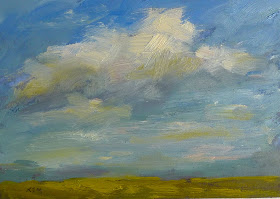 |
| 'Drive By Clouds' 5x7 Oil on Multimedia Artboard ©Karen Margulis click here to purchase $75 |
Last week I was working on a marsh commission in oil. I had some nice piles of paint that I didn't want to waste so I looked around the studio for inspiration. On the table was a small pastel demo of a cloud. I had used this cloud to showcase the durability of Multimedia Artboard.
I had wet and rewet this cloud painting many times and I had gotten it soaking wet several times! It was still accepting the layers of pastel and had not warped or buckled.. I love this surface! But I didn't really love the painting. It had served it purpose as a demo. But it wasn't over yet. Out came my 'What If' attitude.
What if I used the remaining oil paint to paint over the pastel cloud?
 |
| pastel study on Multimedia Artboard |
The painting dried without a problem and I plan to varnish it as usual. The Multimedia Artboard held up beautifully. I think that since I had fixed the layers of pastel with water it made the surface more stable. But after the fact I decided to do some research on putting oil paint over soft pastel. Here is what I found on the Pastel Society of America website:
The German expressionist painter Max Beckman sometimes combined soft dry pastel with oil. The pastel would be used as a preliminary sketch on the canvas. Oil paint can be applied over the soft pastel. The solvents in the oil paint will penetrate the soft pastel. Edges of forms sketched in pastel can be left exposed on the finished oil painted canvas. Even large areas of soft pastel can be free of oil paint application. Large areas of pastel would need protection with a light coat of a varnish-based pastel fixative, such as those made by Sennelier and Winsor & Newton. Do not use an acrylic-based fixative, such as Krylon or Lascaux on oil paint. Mask off the surrounding areas of the oil painting when applying the fixative.
I had fun with this process and will definitely try it again!

I love your final effect.Good for you for following your instincts.
ReplyDeleteI cannot see any reason why it would not be archival. It is following the fat over lean principle.Hope you try some more.
sounds fun..since i am new to art, i dont know better? and i will use pastel, watercolor, and then some times acrylic if i run out of w/c..anything to get what i am after..doesnt always work, glad to see yours did..experiment is my motto,i dont know till mi try!
ReplyDeleteI need to to thank you for this good read!! I certainly loved every bit of it.
ReplyDeleteI have got you book-marked to look at new things you post…
My blog: Website ()
Thanks for sharing. I had a dilemma since I didn’t like my pastel chalk painting but didn’t want to waste the canvas. I ended up using oil and like it much better. Lesson learned!
ReplyDelete